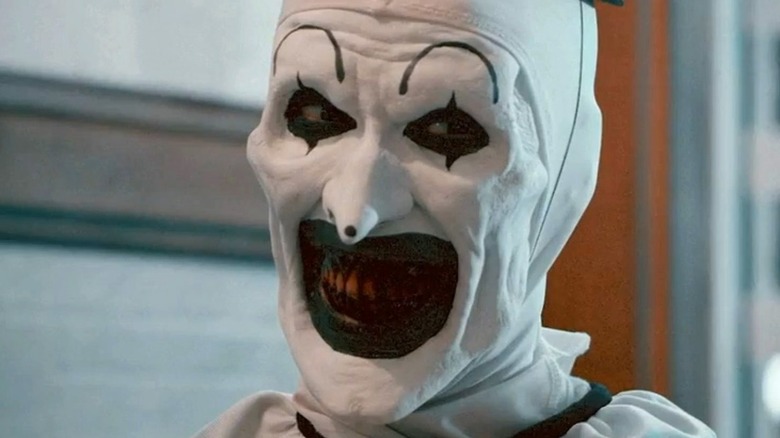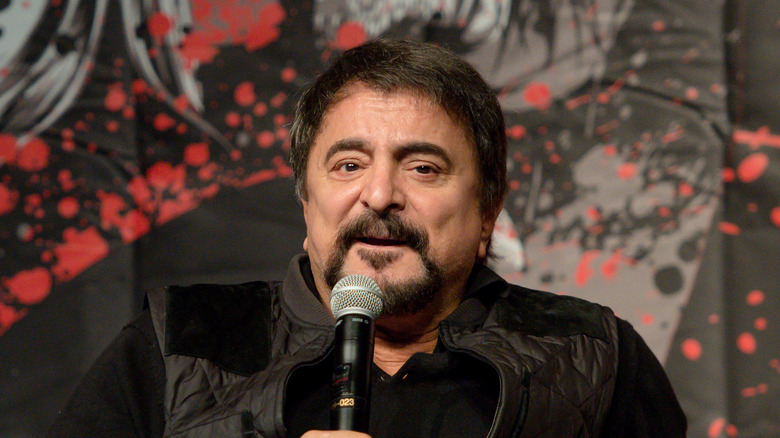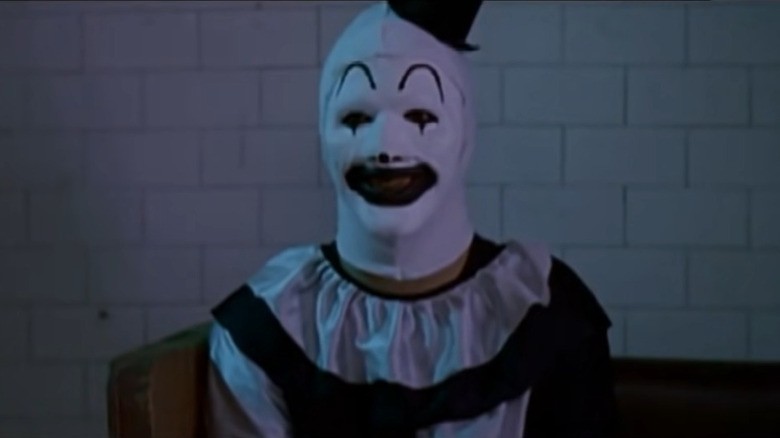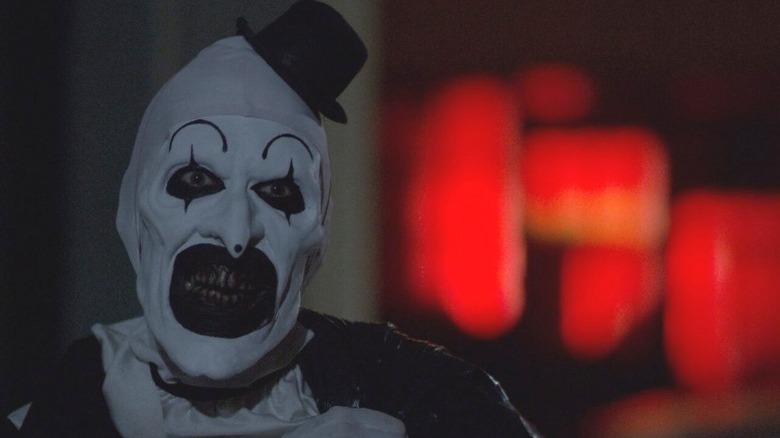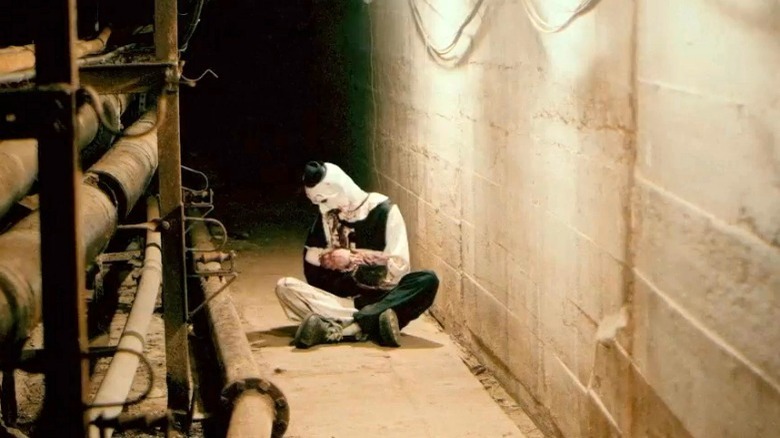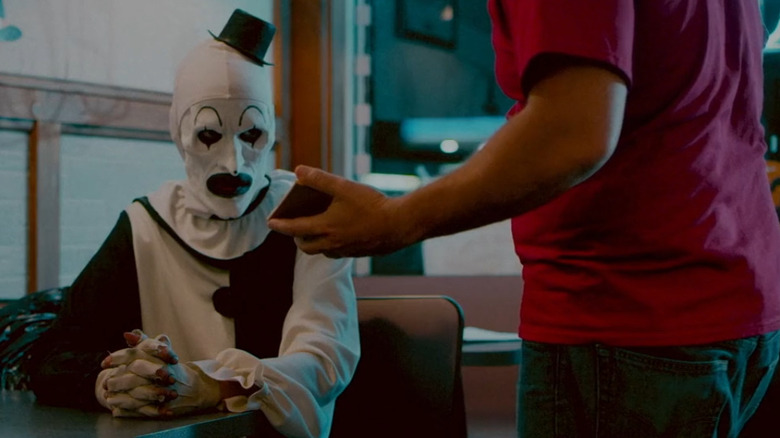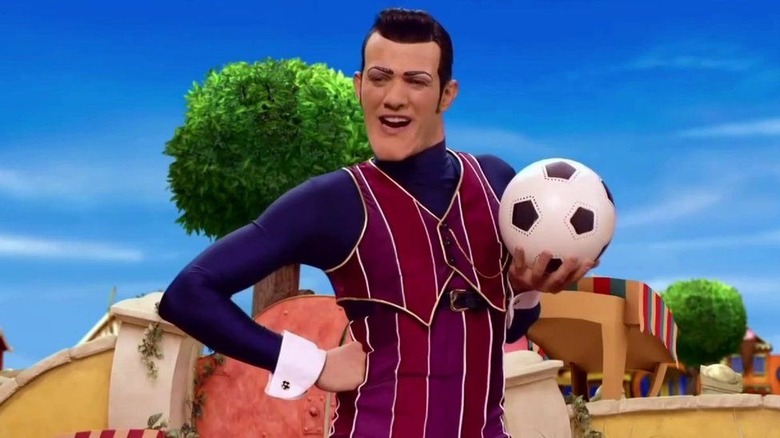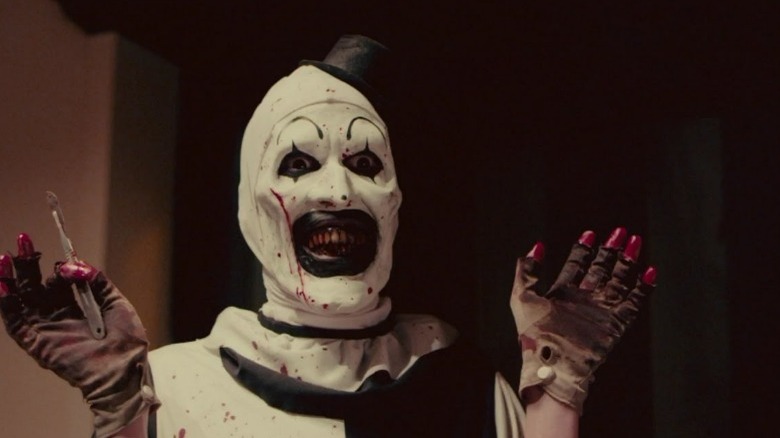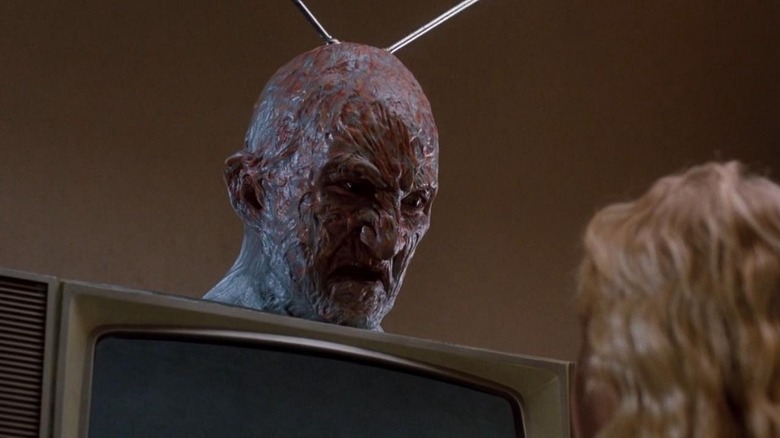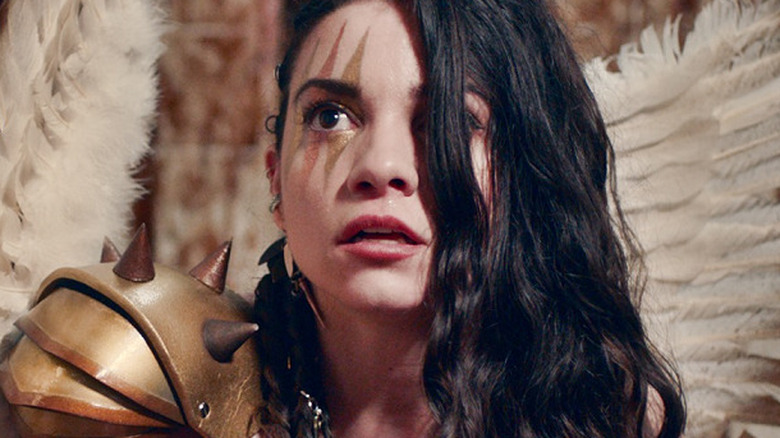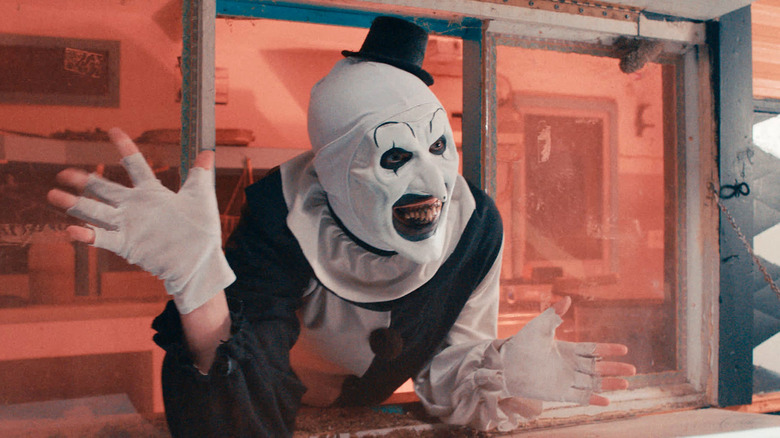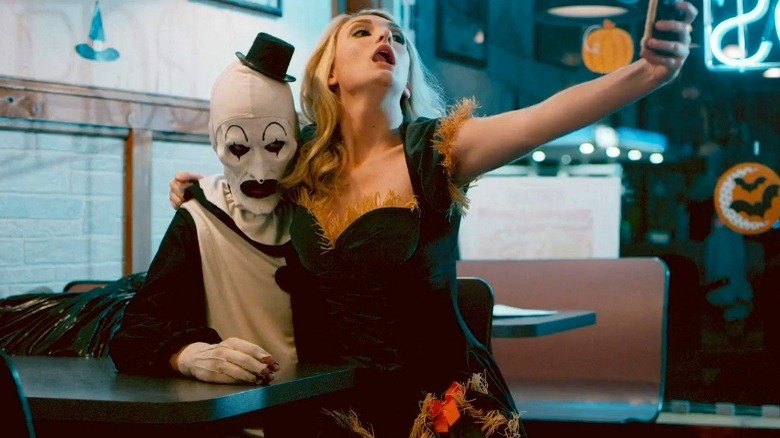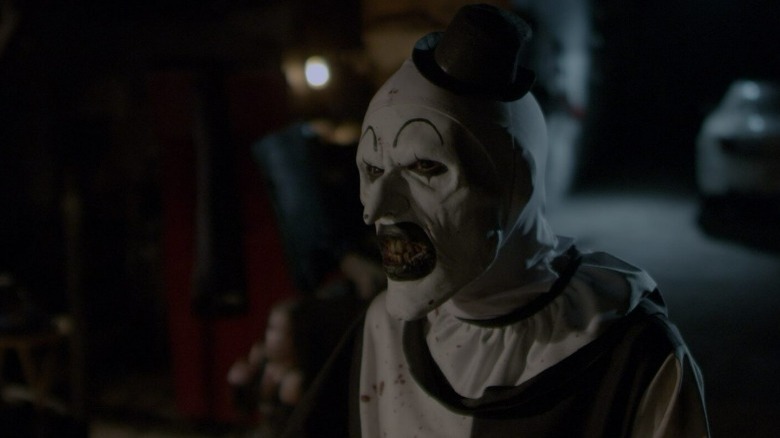All The Gory Details About Terrifier
Looking back, 2022 established itself as a year that brought a slew of new and radically diverse horror films that engrossed their audiences. From "Barbarian" to "Pearl" to "Halloween Ends," it has been a solid year for murderers, madmen, and monsters.
However, one film that has had everyone talking is Damien Leone's "Terrifier 2," the follow-up to his 2016 film "Terrifier." The first film has gone on to amass a fairly sizable cult following due mainly to its antagonist, Art the Clown. From his horrific design to his macabre mannerisms, Art has quickly achieved iconic status within the horror community.
With the sequel having slayed it at the box office — pulling in over $5 million against its $250,000 budget — the franchise has most definitely surpassed anyone's expectations. The future definitely looks bright for Leone and Art the Clown, which only makes the story behind the films all the more intriguing. Here are just a few extra details that'll help you appreciate the "Terrifier" franchise just a bit more.
Damien Leone was inspired by Tom Savini
When it comes to the world of horror movie special effects, few names are as lauded and appreciated as horror legend Tom Savini. From "Dawn of the Dead" to "Creepshow" to "Friday the 13th," the man's work has been behind several iconic genre staples. If it has blood, slime, sharp teeth, or some form of revolting decay, there's a good chance that Savini's influence has reached it. It should be no surprise that Damien Leone had his interest in special effects work sparked by the work of Mr. Savini.
In an interview with Macabre Daily, Leone noted, "When I was 7, I discovered a VHS documentary called "Scream Greats." It is an hour-long documentary on Tom Savini and his special effects work." Since that first exposure, Leone was hooked on the inner workings of special effects work which soon became his main creative passion. It makes sense why Leone's filmography, going as far back as "The 9th Circle," has been heavily predicated on grisly special effects.
Art was originally a side character
For as long as Damien Leone has been making gonzo, special effects-heavy films, Art the Clown has been by his side. Opting not to attend film school, Leone instead asked his mother for a loan to fund his own homegrown horror short (via Screen Rant). That short in question ended up being "The 9th Circle," filmed over the course of two years and released in 2008.
In "The 9th Circle" we're thrown into a simple setup. A girl named Casey is waiting in a train station late one dark Halloween night. Soon enough, Casey is joined by a strange man in a black and white clown costume who begins to irritate her with a horn. She's then attacked by the clown, who injects her with a sedative that quickly forces her into unconsciousness. Upon awakening, Casey and two other girls find themselves at the mercy of inhuman creatures.
In an interview with Fangoria, Leone elaborated more on the short and its use of the Art the Clown character. One major difference between Art here and in his later appearances is his design, which is considerably more subtle in "The 9th Circle," where he is essentially just a man in clown makeup. Additionally, Art is basically the precursor for the short's other monsters — which include Satan himself — a far cry from the leading man he was to become.
Terrifier began as a short film
However, soon after the release of "The 9th Circle," it became clear that the main thing everyone couldn't stop talking about was Art the Clown (via Fangoria). Leone took note of this interest which, in conjunction with a producer's encouragement, spurred a spin-off short that was released in 2011. Sharing the same name as the subsequent feature film, "Terrifier" showcases a short, succinct, and disturbing Art the Clown story.
A costume designer stops at a gas station where she sees Art being forced out for smearing his feces on the bathroom wall. As is now par for the course, this soon escalates into Art gruesomely dismembering the station attendant and giving chase to the designer. Despite her best efforts to escape, the designer soon finds herself at Art's mercy and has all of her limbs removed. In spite of its choppy editing and acting, the short was an effective test run for Art the Clown as a main antagonist.
This short and "The 9th Circle" were both released with additional segments as an anthology film titled "All Hallows' Eve" in 2013. It was becoming clear that Art the Clown was steadily catching on as a recognizable antagonist and was no longer just a visually distinct side character.
Art's original actor
When it comes to slasher villains, it's actually a rarity for the killer to always be played by the same actor. Much like Jason Voorhees and Leatherface, there have been more than one person to fill the floppy shoes of Art the Clown.
The character of Art the Clown developed as different actors assumed the role of the man behind the latex. Before David Howard Thornton donned the white face paint, the first actor to play Art the Clown was Mike Giannelli. Giannelli, while lacking the mime skills of Thornton, still added a lot to his interpretation of Art the Clown. In fact, the gleeful sadism and demented humor that's made Art so popular with horror films shine through in Gianelli's original portrayal of the character.
During the development of "The 9th Circle," Leone often workshopped the story with Gianelli, even crafting rough sketches along the way (via Fangoria). It was from these conversations that Art got his name when Leone and Giannelli noted that "This guy is like a work of art." This served as the catalyst for the morbidly artistic ways that Art will often present his victim's bodies after he kills them.
The first film's Indiegogo flopped
With "All Hallows' Eve" cementing the appeal of Art the Clown as a lead villain, Leone was inspired to pursue a feature film. The director did what many other amateur filmmakers have done and turned to the power of the internet for funding, launching an Indiegogo campaign in 2015. Sadly, the final number fell very short of the intended $15,000 goal, meaning Art's cinematic future was unfortunately stuck in limbo. This was until fellow filmmaker Phil Falcone stepped in to help Leone right the ship and get things back on track. In exchange for a producer credit, Falcone opted to put up the necessary funds to make Leone's film a reality (via DreadCentral).
Leone took every cent of the received funds and opted to put most of it into the film's true draw — the special effects. It was this tidal wave of red corn syrup, mutilated heads, and bisected bodies that helped cement the film's identity. It's hard to imagine "Terrifier" without its exceptionally gruesome body count, so this was definitely money well spent.
David Howard Thornton had a famous mentor
A huge contributing factor to Art the Clown's ever-growing appeal is the man who plays him, David Howard Thornton. Taking over the reins from Mike Giannelli, Thornton truly made the role his own and immediately infused it with his own unique flair. With a level of physicality comparable to that of a mime, Thornton showcased a wide range of impressive facial expressions. From his demented grin to his mute laughter to his sinister sneer, Thornton had zero issues injecting Art with heaps of personality. Despite being a hyper-violent psychopath, Art maintains an unwaveringly morbid charm despite the many blood-drenched crimes he commits.
In an interview with Dread Central, Thornton explained how much of this heightened physicality was inspired by silent film stars. "Buster Keaton, Charlie Chaplin, Laurel and Hardy – and they had to convey all that meaning with just their faces and physical movements, and I also did a lot of physical comedy in the shows I was in," Thornton said.
Thornton also mentioned being influenced by Doug Jones and Rowan Atkinson and, most importantly, his mentor Stefán Karl Stefánsson. Many might remember Stefánsson as the man who portrayed the comically evil Robbie Rotten on the children's show "LazyTown." If you take note of Robbie's overly-animated movements, it's impossible not to see his influence on Thornton's portrayal of Art.
Leone wanted to disgust audiences
Horror cinema is experiencing a truly special revival on both the big and small screen — especially thanks to streaming. Nowadays, especially outside of the MPAA's purview, directors have been able to push boundaries once thought impossible. "Terrifier" is no exception to this, as the film has been widely recognized for its unrelenting sadism and gruesome special effects. For some, the film's masochism is a bit too much, even bordering on excessive, but this was actually a calculated move from Leone.
In an interview with Dread Central, Leone laid out his reason for wanting to create kills that lingered longer and showed far more. He explains, "So just packing it with special effects and making them as graphic as possible, I knew that we would stand out. I wanted it to be as graphic and as grisly as possible." This strategy definitely polarized some critics, with a surge of love and disdain being tossed at the film in equal measure. However, one can't deny that Leone's strategy worked, resulting in a cult hit that resulted in a sizable fandom and a sequel.
The series' classic influences
In most cases, when a director is interviewed, they'll often list off any eras of cinema or specific titles that influenced their work. When it comes to the "Terrifier" movies, Leone has been very vocal about the specific vibe he was looking to create. Leone told Bloody Disgusting, "To me, this is sort of a throwback to slashers that we don't get anymore." He noted examples such as "A Nightmare on Elm Street Part 3: Dream Warriors" — a film that has a healthy balance of graphic horror and supernatural elements.
If you watch both "Terrifier" films, it isn't hard to see that Leone has taken quite a few cues from various subsections of the horror genre. Leone also noted his affinity for Grindhouse-style movies and how they played a part in the first film's aesthetic (via Bloody Flicks). Much like the films of that genre, both "Terrifier" movies weren't interested in subtlety as much as they were in pure shock value. It's very clear that Leone has a great affinity for the horror genre at large and that appreciation is communicated clearly to the audience.
Sienna's character was planned from the beginning
Another aspect of "Terrifier 2" that has attracted a lot of praise is its lead character, Sienna, played by Lauren LaVera. Many online critics, including Chris Stuckmann, reserved special praise for LaVera's portrayal of the sequel's final girl. We are introduced to Sienna in the film's opening credits where she's seen constructing a glorious pair of cosplay angel wings. LeVera adds a welcome amount of heart to the film, making the perfect counterpoint to Art's relentless cruelty and forming the film's emotional center. Sierra's importance in the sequel makes a lot more sense when you learn how long Leone has had her character planned out.
According to an interview with Halloween Daily News, the idea of a protagonist dressed as a warrior angel was something Leone had in his pocket for many years. Immediately after making "The 9th Circle," Leone was keen on jumping into a feature-length Art the Clown movie. This unmade version's formative concept was to follow a protagonist dressed like an angel, a prototype version of Sienna. It wasn't until LaVera dazzled Leone with her audition that he knew he'd found the right person for the job.
Art has become a new horror icon
In this day and age, it's becoming increasingly difficult for horror antagonists to break through to the mainstream. However, when a character does start to attract the attention of the general public, it's not uncommon to see them pop up in other forms. Since his debut, Art the Clown has steadily risen in popularity, even becoming an increasingly popular costume for horror movie conventions. Given the resurgence of creepy clowns as a horror trope in the 2010s, Art made for a welcome addition to the horror movie community.
During a conversation with the Austin Chronicle, Leone mentioned his appreciation for the growing Art fandom: "There was a time when we could count them on one hand, and now there are literally thousands. ... Every day I check #Terrifier and every day something new pops up, something wonderful." Fans have shared everything from tattoos, to drawings, to photos of their various pieces of Art the Clown merchandise. Art the Clown — much like Freddy Krueger, Michael Myers, and Jason Voorhees — has taken on a life of his own.
Leone used criticism to his advantage
Despite the widespread success of the first film, Damien Leone still received a fair amount of criticism for "Terrifier." One film critic from Cinema Crazed even saw fit to refer to the film as "a very disposable party favor you'll have forgotten once the credits roll." Among the heaps of praise for the film, it seems many couldn't get into its somewhat mean-spirited tone which, in fairness, is particularly sadistic.
Leone himself commented on this when being interviewed for Horror Geek Life, noting, "I read every criticism and every comment. I love to hear feedback, no matter what people say. A lot of it is that this film, in a negative way, is mean-spirited. I always say I don't intend for the film itself to be mean-spirited, but Art the Clown is very mean-spirited. I write him to be super mean-spirited."
These criticisms prompted Leone to work hard to make the sequel a more well-rounded film. This resulted in a more character-based screenplay, which leans more into family drama and emerging supernatural elements. In regards to Sienna, the film's protagonist, Leone said, "I think you can spot that and hopefully feel that there's something genuine going on in there. It was very important to build up the drama because I wanted the audience invested in these characters and get behind Sienna and her journey of discovering her role in regard to Art the Clown."
The sequel's Indiegogo was a huge success
"Terrifier" fans were ecstatic when Damien Leone revealed that he'd completed the first draft of the screenplay for the sequel. Leone even noted that this follow-up was shaping up to be bigger and badder than the previous outing. However, with these loftier ambitions came the need for a bigger budget to properly craft Art's next onscreen rampage. The first film's success made it much easier to secure the baseline funding to get the film underway, although there was still one hitch.
Leone had an idea for a scene that, if attempted, would necessitate a fairly substantial budget for the proposed special effects. So Leone opted to go back to the crowdfunding well once again, a bold move considering it didn't go super well the first time. Leone launched a new Indiegogo campaign partway through 2019 in order to accrue $50,000 for the proposed scene. In a wonderful turn of events, the campaign met and even surprised its original goal in hours (via Dread Central). By the end of the Kickstarter campaign, over 1,000 backers had donated a grand total of $215,127 — over four times the amount originally asked for.
